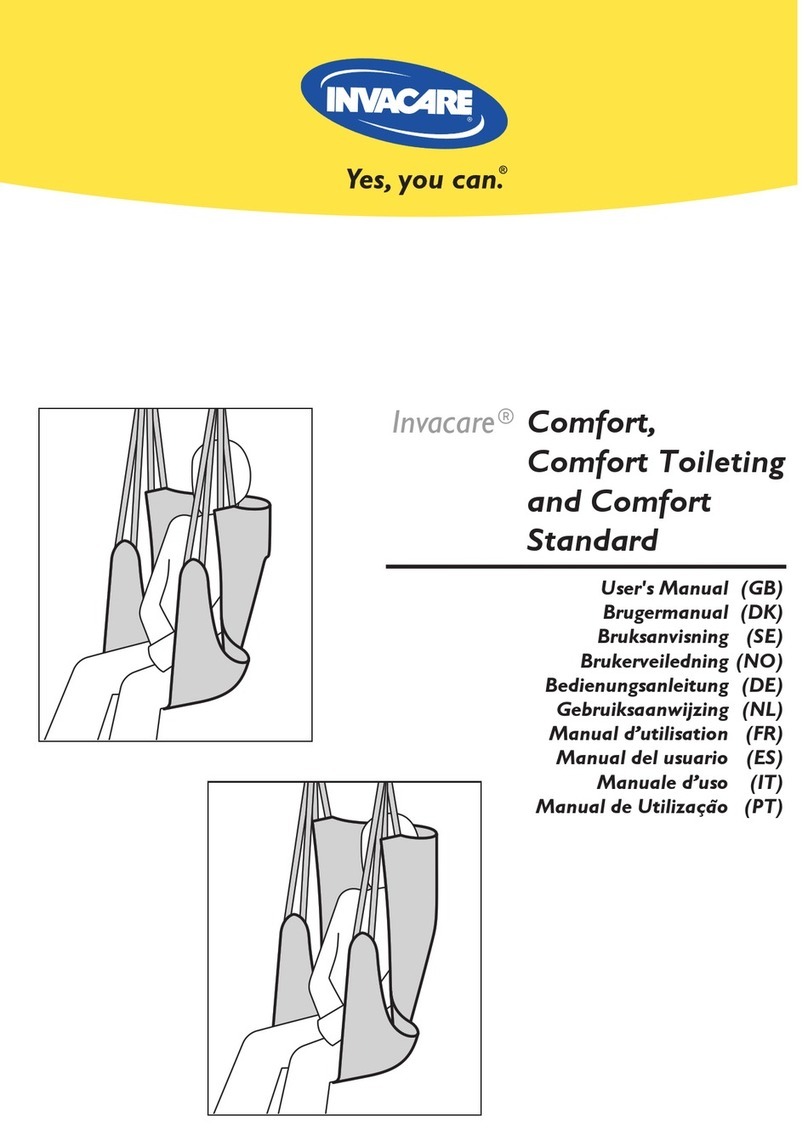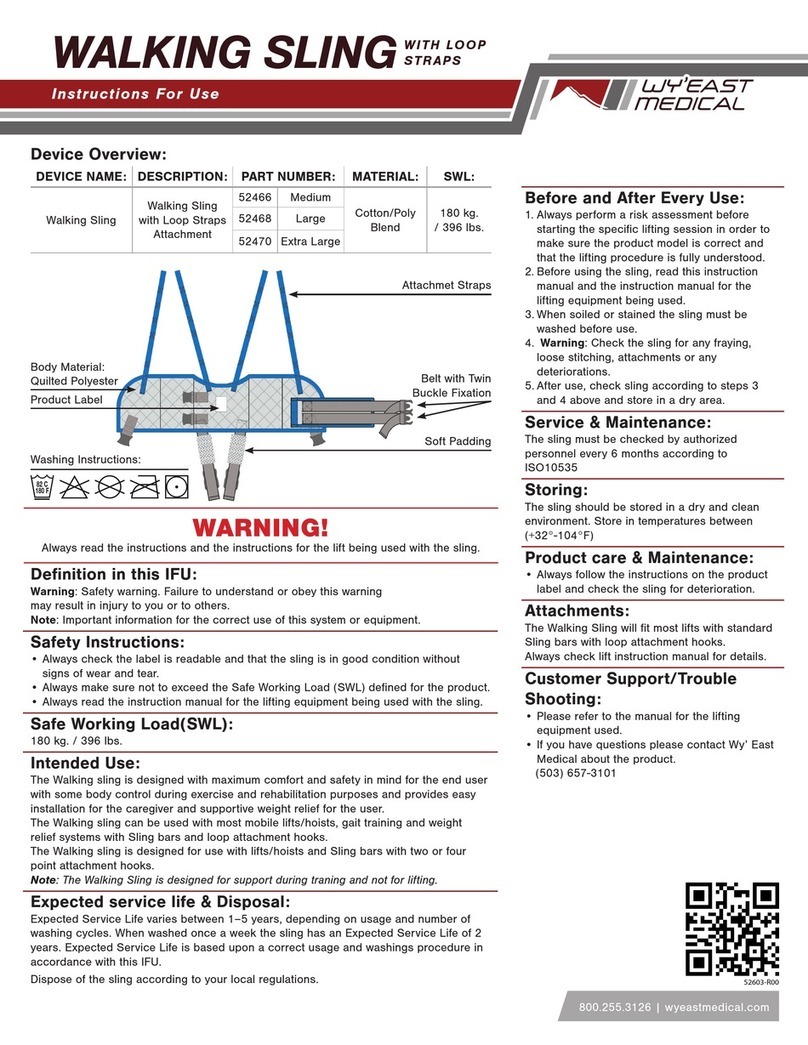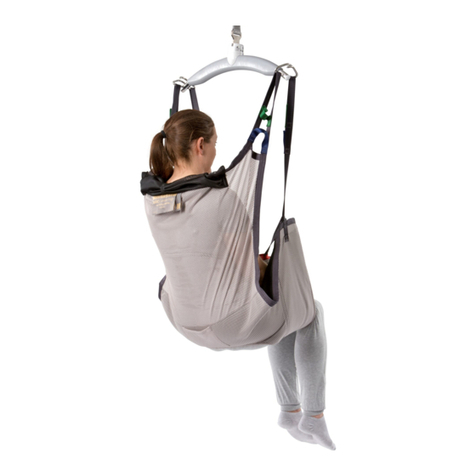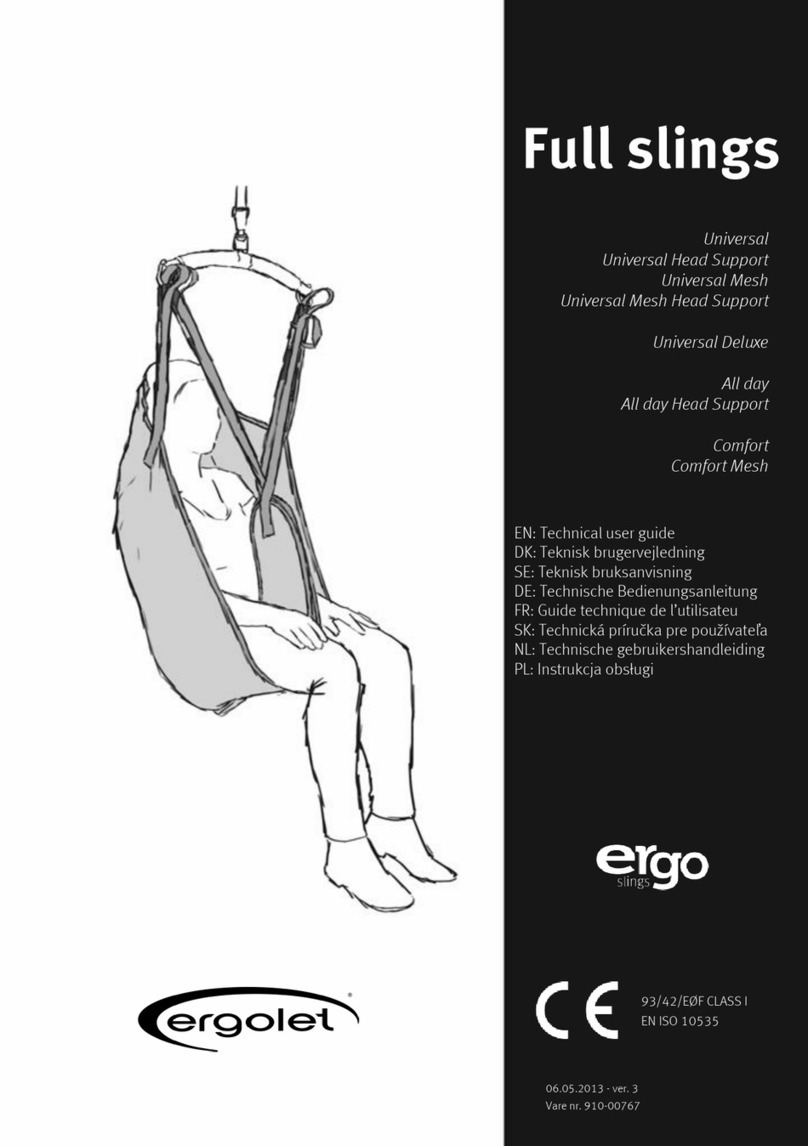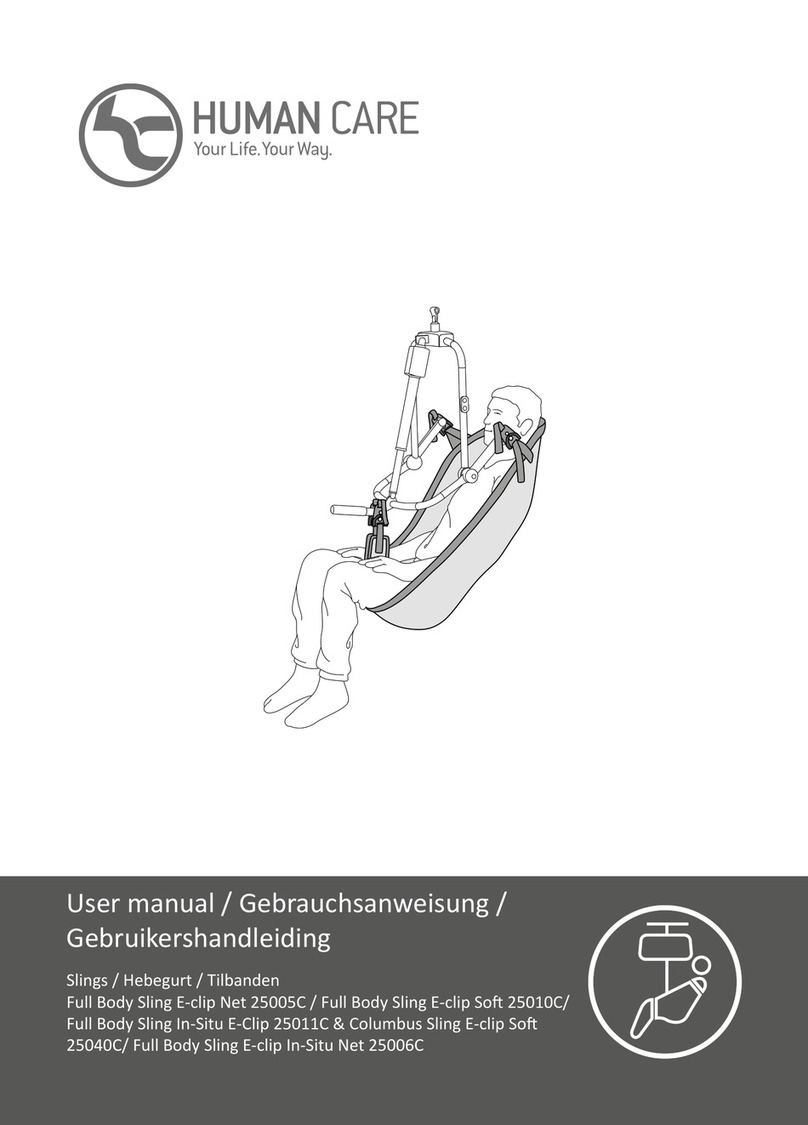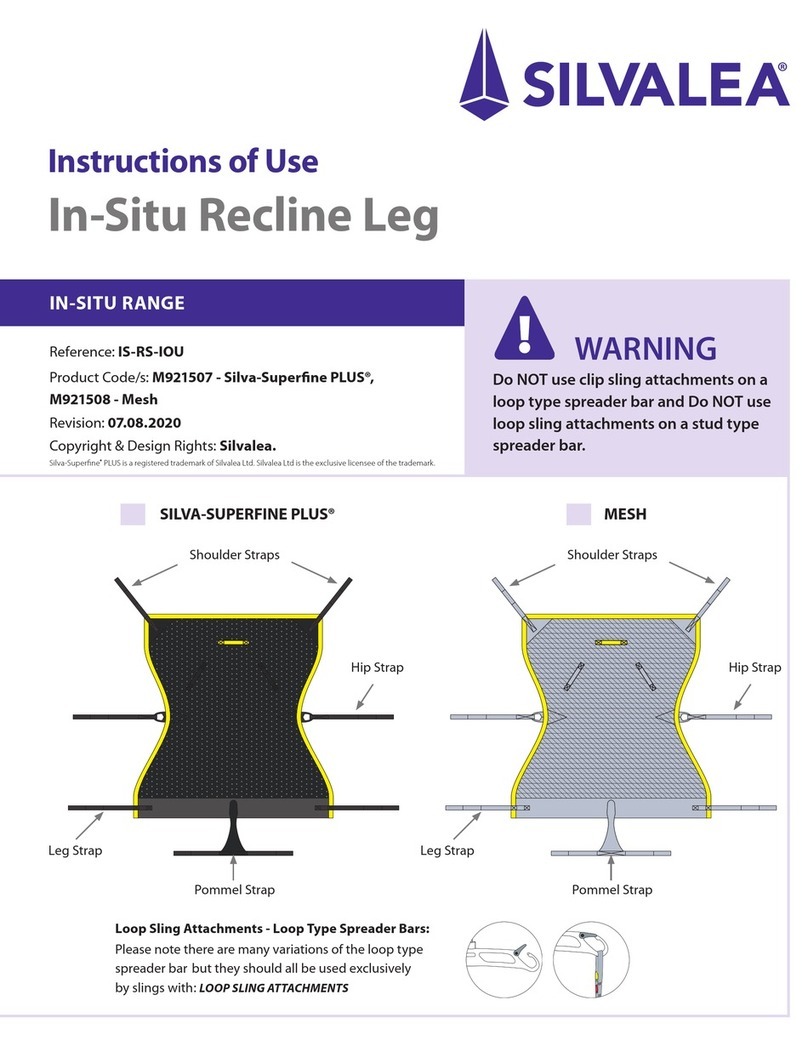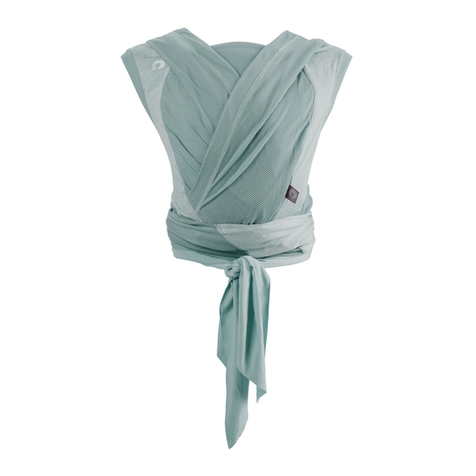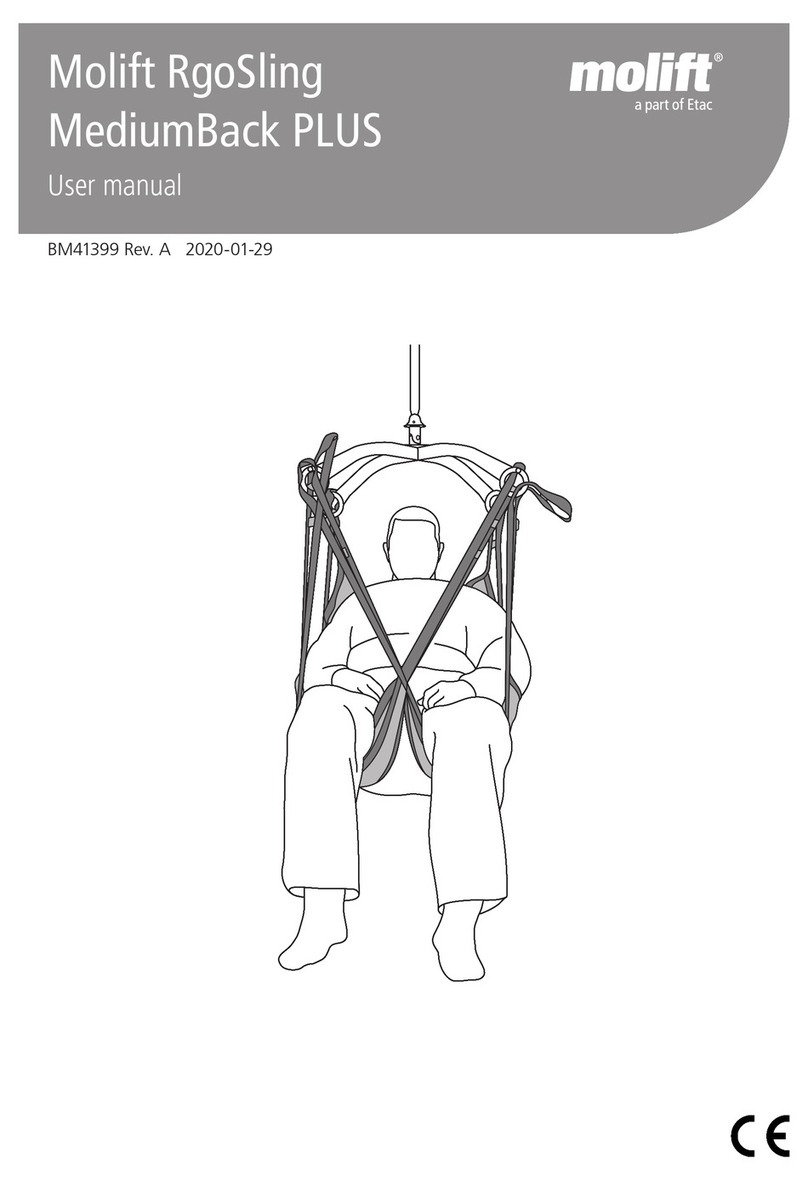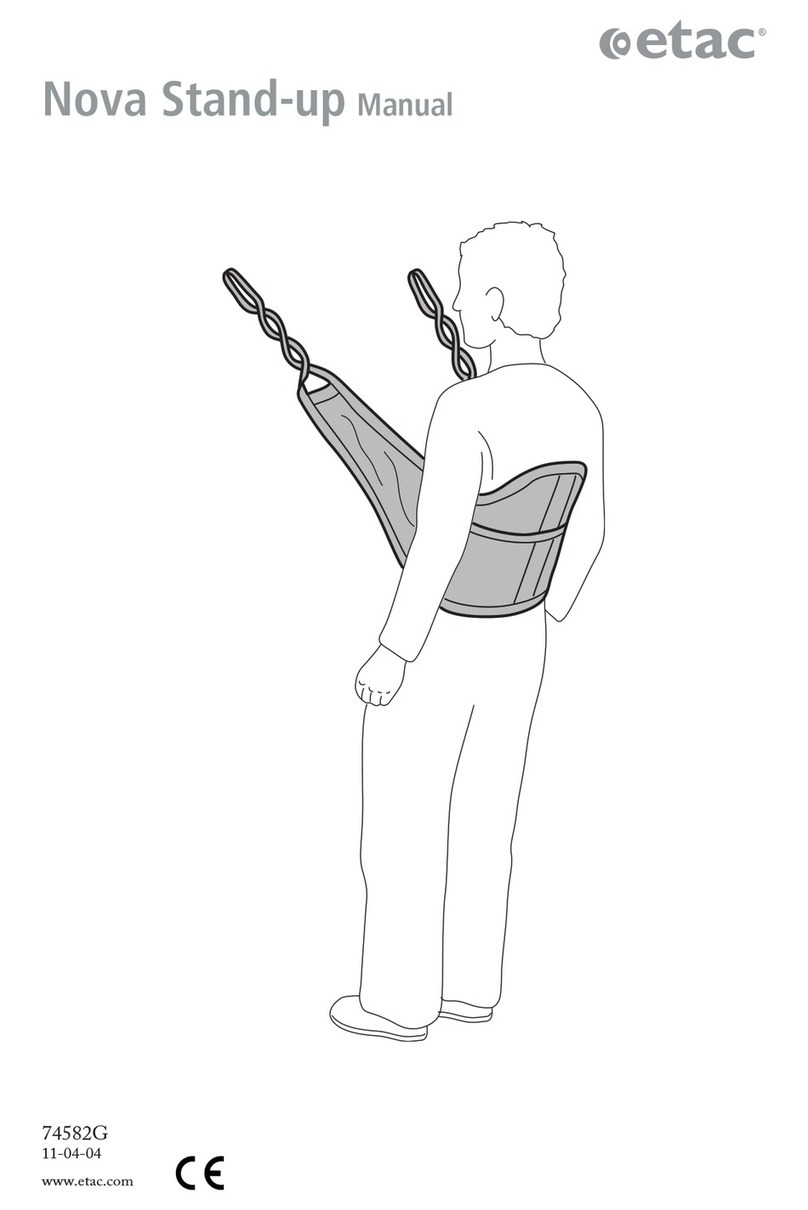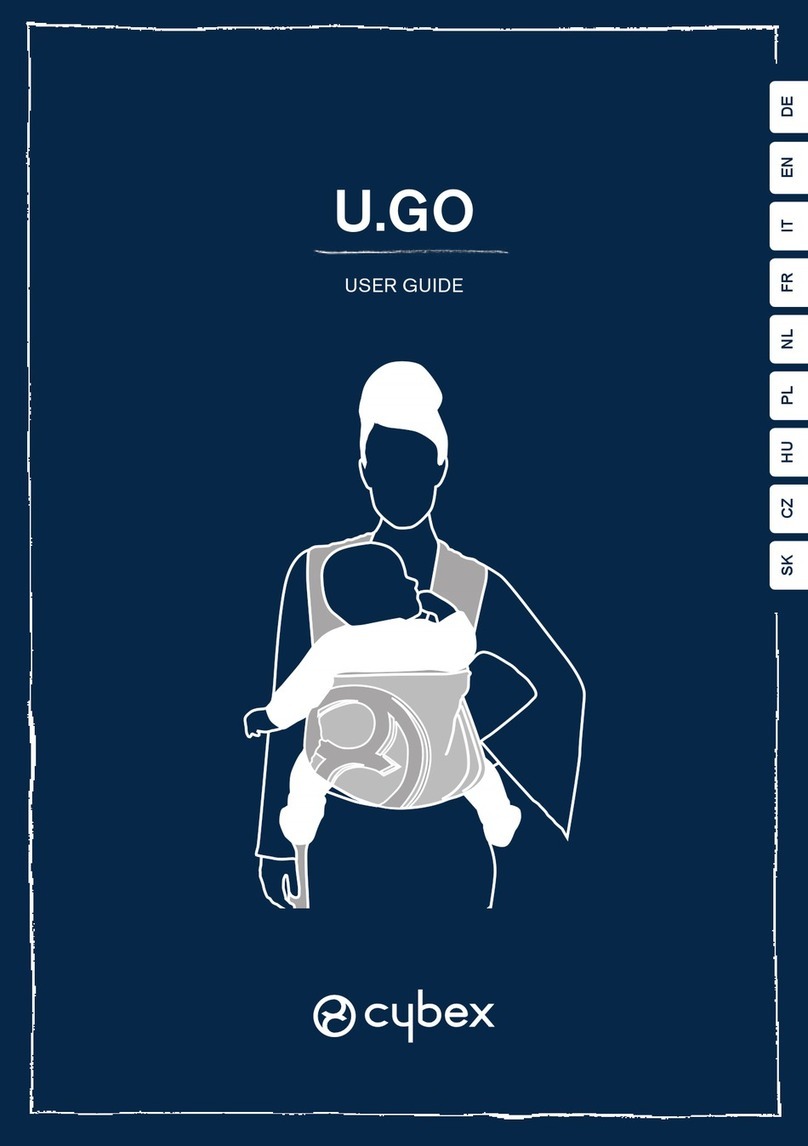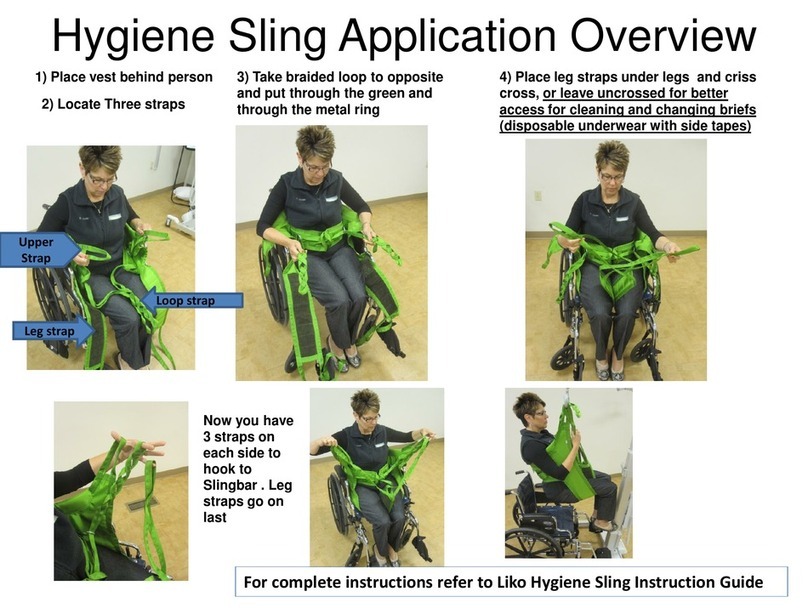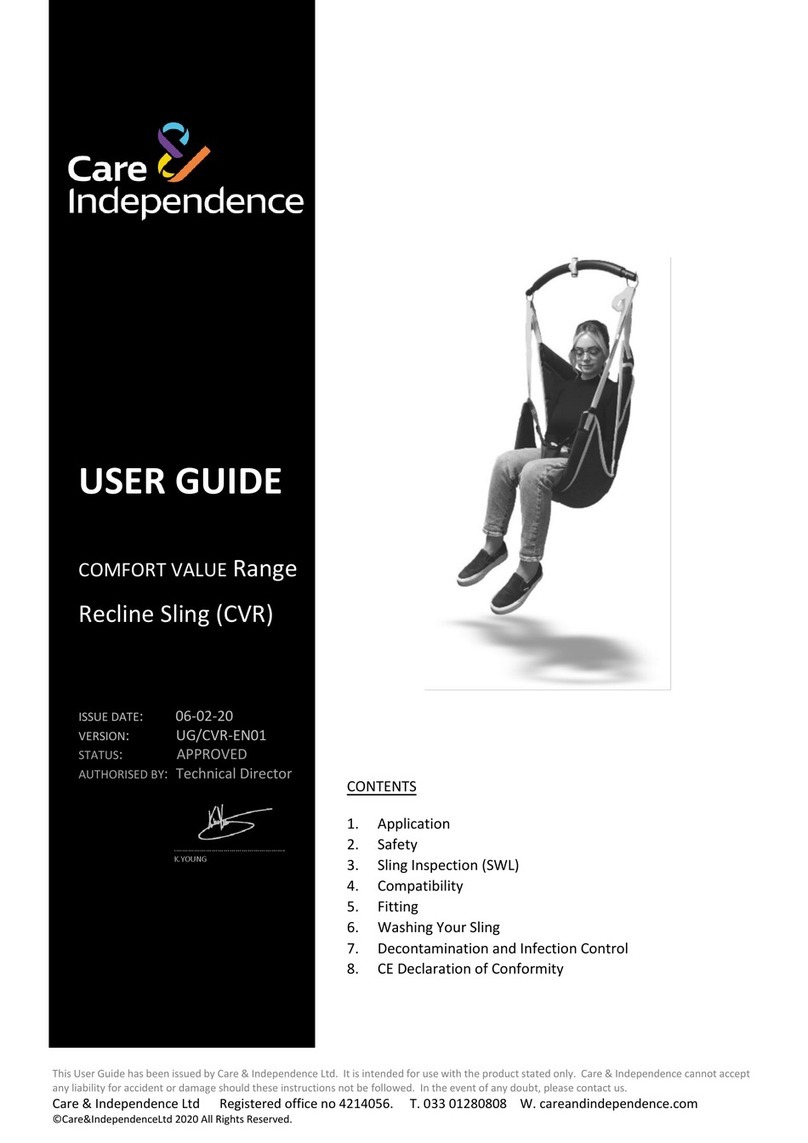Prism Medical UK Prism Deluxe Support Sling User manual

Prism Deluxe Support User Guide Rev 5 -Jan 2015 page 1
© Prism Medical UK 2015
User Manual
Prism Deluxe Support Sling

Prism Deluxe Support User Guide Rev 5 -Jan 2015 page 2
© Prism Medical UK 2015
Prism Deluxe Support Sling
Application
The Deluxe Support Sling provides maximum support to the sacral area and is used
in cases where the Universal Sling is unsuitable because the individual has poor
lower body tone. It can be used to transfer from the seated to recumbent position or
from recumbent to seated. The person must be assessed by a competent person
who must be fully trained in the suitability, application and fitting of the sling. Carers
should always be trained in the use of hoists and slings.
Sling Inspection
All Prism Slings are manufactured to meet and exceed the requirements of
BS EN 10535:2006 ’Hoists for the transfer of disabled persons– Requirements and
test methods’. Slings should be inspected prior to use and after washing. Damaged
or badly worn slings should be discarded. The label on the sling contains vital
information to identify the sling -if any part of the label becomes illegible, then it
must be removed from service and replaced.
The sling should be visually inspected with regard to the following items:-
Any signs of damage (i.e. Cuts, frays, tears, burns) to the sling straps
Any signs of stitching becoming undone on any part of the sling
Any signs of the fabric being stretched, tearing or undue wear
Any signs of discolouring or bleaching on the material
Is the sling complete? i.e. all straps present, stiffeners in place -where
applicable, etc
Label clearly legible
Compatibility
The issue of sling compatibility with various manufacturers’ hoists has been a
concern for specifiers for a number of years, an issue that is compounded by the
increased number of companies supplying hoists and slings.
Some hoist/sling manufacturers will state that only slings manufactured by them can
be used on their hoists and vice versa. This is their policy only and is NOT a legal
requirement. A risk assessment must still be completed even if the same man-
ufacturer of hoist and sling are to be used, and the specifier simply has to state that
the carry bar is of a similar design and that the sling manufacturer has authorised
its use on it.
A comprehensive list is available separately and your local agent will be able to
provide assistance with compatibility issues.
Maximum Load (Safe Working Load -S W L)
The maximum load for the sling is clearly marked on the label of the sling. The
maximum load will also be displayed on the hoist and any detachable elements of
the hoisting system.
DO NOT exceed the maximum load stated on any of the equipment.
Prism Deluxe Support User Guide Rev 5 -Jan 2015 page 3
© Prism Medical UK 2015
ABC
Child 500 490 440
Junior 680 570 500
Small 750 600 570
Medium 820 650 630
Large 900 680 750
X Large 950 700 780
Sling Dimensions
A
C
B
All dimensions have a tolerance of +/-20mm
NOTE: All slings are available either with or without Head Support

Prism Deluxe Support User Guide Rev 5 -Jan 2015 page 4
© Prism Medical UK 2015
Hoisting from a chair
Introduce the sling by sliding it down between
the chair backrest and the person’s back until
the top of the commode aperture reaches the
base of the spine. If the sling can not be
introduced from behind , apply the sling in a
position level with the person. Leave the sling
half way down the persons back (at this stage
don’t bring the sling to shoulder level).
Bring the leg sections along-side the person’s
thighs and pull lightly to ensure that they are of
equal length. Using good manual handling
techniques, raise the persons leg and feed the
leg sections under the person’s thighs.
Cross strap A through the loop at the base of
strap B. Pass strap C through loop A and pass
strap D through loop B. Now raise the top of the
sling level with the person’s shoulders. The
fitting of the sling is now complete.
HOW TO FIT FROM SEATING POSITION
b
Note: The person to be transferred shall be referred to as “the person”.
C
AB
D
3
12
4
The four straps should now be attached to the
carry bar hooks. Raise the carry bar just
enough to tension the straps and ensure that
they are still securely attached. The person
can now be lifted as required.
To remove the sling, carry out the fitting procedure in reverse.
Important -always peel the sling away from the person to avoid skin friction and movement.
Notes
The above techniques are for guidance only and you must comply with your local policies
If in doubt, consult your moving and handling advisor
Prism Deluxe Support User Guide Rev 5 -Jan 2015 page 5
© Prism Medical UK 2015
Using good manual handling techniques
roll the person towards you so that they
are positioned on their side . To introduce
the sling, roll half of the sling up
underneath itself so that when the person
is rolled onto their opposite side, the sling
can be unrolled until it is flat. Use the
centre markers to ensure the base of the
back section is in line with the base of the
person’s spine. Ensure that handle loops
Pass the leg section under and up between
the thighs. Ensure that as much section as
possible is pulled under the leg and that all
creases are eliminated to achieve max-
imum comfort.
Cross strap A through the loop at the base
of strap B Pass strap C up through strap A
and pass strap D through strap B. The
fitting of the sling is now complete.
The four straps should now be attached to
the carry bar hooks. Raise the carry bar
just enough to tension the straps and
ensure that they are still securely
attached. The person can now be lifted as
required.
2
3
C
AB
D
Hoisting from the floor
Before commencing the manoeuvre, introduce a pillow to ensure the client is
comfortable. Follow the procedures 1-2 as above to fit the sling. If using a mobile hoist,
introduce the hoist using the method approved in your local area so that the carry bar is
positioned correctly above the client.
Procedure 3 can now begin.
Hoisting from a lying position
To remove the sling, carry out the fitting procedure in reverse.
Important -always peel the sling away from the person to avoid skin friction and movement.
Notes
The above techniques are for guidance only and you must comply with your local policies
If in doubt, consult your moving and handling advisor
1

Prism Deluxe Support User Guide Rev 5 -Jan 2015 page 6
© Prism Medical UK 2015
Taped Head Support
The Hammock sling is also available with a
taped head support.
The additional straps connect to the carry bar
direct onto the same hooks that the shoulder
straps are attached to. ( see photo 1)
The additional straps are adjustable to suit
the clients head position and level of support.
( see photo 2).
Photo 1
Photo 2
Prism Deluxe Support User Guide Rev 5 -Jan 2015 page 7
© Prism Medical UK 2015
Prism Deluxe Support Sling -Material Variants / Uses
Standard Slings
Poly: The sling is made from a close knit polyester material and has nylon ‘rip
stop’ material to the outer side of the leg sections to aid the fitting of the
sling. This is a general purpose sling and can be used for sitting and
Recumbent transfers between chairs, beds, baths, changing beds, WC’s
etc.
Spacer: The sling is made from knitted polyester “spacer” fabric that is
manufactured with an ‘air gap’ internally. The material stretches slightly
in all directions and moulds perfectly to the shape of the person being
hoisted. This is a general purpose sling that can be used as the Poly but
has the added benefit of being suitable to be left in position if required
(subject to risk assessment and monitoring of pressure risks).
Mesh: The sling is made from a polyester net material and has a non-absorbent
foam in the leg sections. The inner surface of the leg sections has a
close knit polyester covering for patient comfort. This sling is designed
specifically for bathing and can be left in place whilst the person is being
bathed/showered.

Prism Deluxe Support User Guide Rev 5 -Jan 2015 page 8
© Prism Medical UK 2015
SLING CARE: LAUNDERING
GENERAL.
Sensitive laundering of lifting slings will extend the service life of the product.
Conversely, improper laundering will reduce the service life and possibly affect the
strength and integrity of the sling.
To be avoided:
Use of bleach at washing, particularly hypochlorite [may cause structural
damage]
Overheating the sling [temperatures in excess of 100º may cause extreme
shrinkage and structural damage]
Use of non-biological detergents is not recommended (especially Fairy Non -Bio):
as these types of detergent contain bleaching agents that can degrade the strength
of the sling.
The use of fabric conditioners is not recommended.
Any hook & loop fastenings should be closed prior to laundering to avoid the ‘hook’
side damaging the sling or other items laundered with it.
GENERAL SOILING.
The sling should be laundered with soap or detergent at 50°C on a standard
domestic cycle.
DISINFECTION.
The sling should be laundered to ensure a ‘period at temperature’ of:
10 minutes at 65ºC
3 minutes at 72ºC
Following NHS guidelines, extra time should be added to ensure thorough mixing of
hot water through the wash load.
It may be that available equipment does not allow the required level of temperature
control. The sling may be washed on a 90ºC wash cycle, though it is likely that
some moderate shrinkage and/or colour bleed will occur.
DRYING.
Slings will air dry quite quickly in a warm room.
Slings should not be placed over radiators or convectors.
Slings may be CAREFULLY tumble dried on a cool [60ºC] setting and short cycle.
The sling should be checked at intervals not exceeding 5 minutes.
Do not allow the sling to overheat.
The sling should last in excess of 5 years if the above guidelines are adhered to. All
Prism slings have a manufacturers guarantee of 12 months.
Prism Deluxe Support User Guide Rev 5 -Jan 2015 page 9
© Prism Medical UK 2015
DECLARATION OF CONFORMITY
Manufacturers Name: Prism Medical UK Ltd
MHRA Registration No: CA 013248
Manufacturers Address: Unit 4 Jubilee Business Park, Jubilee Way,
Grange Moor, Wakefield,
WF4 4TD, UK
Tel +44 (0) 844 980 2260
Declares that the manufactured product:-
Product Name: Prism Deluxe Support Sling
Product Options : Child, Junior, Small, Medium, Large, XL Large.
All slings are available either with or without Head Support.
Conforms to the following European Union Council Directives:-
Directive 93/42/EEC and all amendments up to Directive 2007/47/EC
Classification Class 1, Low Risk Medical Device
Tested in accordance with BS EN ISO 10535:2006 & IEC 60601 3rd Edition
Supplementary Information:
The undersigned declares the product herewith complies with the requirements set out
above and carries the CE mark accordingly.
The Technical Construction File required by this directive is maintained by the
manufacturer as detailed above.
Signed: Date: 14th November 2014
Craig Wright, Manufacturing Director

Prism Deluxe Support User Guide Rev 5 -Jan 2015 page 10
© Prism Medical UK 2015
NOTES
Prism Deluxe Support User Guide Rev 5 -Jan 2015 page 11
© Prism Medical UK 2015
Date of Assessment : FIM Score:
Clients Name:
Approx Weight: D.O.B:
Type of Sling: Size:
Sling Straps Coloured loop Options
Head Support (Option): Adjust slider to suit the persons head position
Shoulder Loop: White Orange Blue/Black Other
Leg loop: Yellow Green Brown Other
Comments
SLING SAFETY
Care Plan Information
All slings in the Prism range have space on the labels to record the clients name.
Each sling has unique individually colour coded lifting loops which helps maintain
good lifting practice. The loop options facilitate variable positions from sitting to
recline.
TRUCTIONS
CARE PLAN INFORMATION

Prism Deluxe Support User Guide Rev 5 -Jan 2015 page 12
© Prism Medical UK 2015
.
Prism Medical UK, Unit 4 Jubilee Business Park,
Jubilee Way, Grange Moor, Wakefield, WF4 4TD
Tel +44 (0) 844 980 2260
www.prismmedical.co.uk info@prismmedical.co.uk
This document conforms to BS EN ISO 10535:2006 Requirements
If you have any questions regarding the use
of this equipment, please contact
Prism Medical UK, or your local authorised dealer
Tel+44 (0)1924 840 100
Table of contents
Other Prism Medical UK Sling manuals




